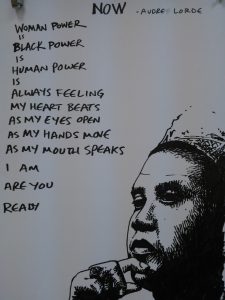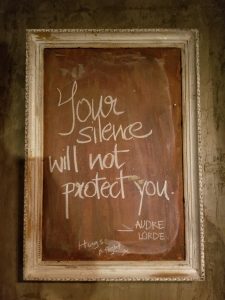1
Alison Carleton
Audre Lorde: Poetry as Activism

Through her written work, Audre Lorde made plain the necessity of intersectionality in environmental causes; advocating for the preservation of an earth that was equally home to marginalized groups while ushering Black, queer, and women voices to take a stand for justice both for the groups pushed to the margins of society and for the earth that belongs in equal part to them. Her poetry and prose challenge readers and listeners of the past and present to include all groups in their pursuit of justice, socially and environmentally. Lorde’s poetry utilizes nature imagery as an integral tool for accurately capturing the human experience. She writes about her connection to the earth in language that mirrors her description of other social identities.

Throughout the work of Audre Lorde two prominent themes related to nature appear. Her work approaches nature as a way to access and communicate the emotional depths and complexity of the human experience, including the process of understanding one’s racial, familial, and social identities. The second theme–which lends credence to Lorde’s effects on intersectional environmentalism–is the idea of nature as hosting a unique connection to women, especially mothers, threatened by industry and “instruments of production”, as phrased by James Manigault-Bryant in his article “Journaling the Body into Nature: Audre Lorde’s Poetic Transgressions of Environment’s Scripture”.

The images provided in this text help establish Lorde’s enduring presence. The first image is a photo of Lorde that gives the viewer a sense of her confidence as she offers the camera a steady and sure smile. The following two images are quotes from her work–one poetry and one prose–that have been incorporated into art or decor in the time since her passing. Since Lorde’s passing nearly thirty years ago, her work continues to move and inspire minorities and activists to action and (of special importance to Lorde) to speech against the injustice occurring toward them and the earth Lorde held beloved. The enduring legacy of her work can be seen simply by interacting with it, encountering descriptions like “As a diamond comes into a knot of flame / I am black because I come from the earth’s inside” from “Coal” and in “From The House Of Yemanjá”:
“mother I need
mother I need your blackness now
as the august earth needs rain.
I am
the sun and moon…”
In these works we see the themes of motherhood and womanhood, race and belonging, and the dichotomy of multiple identities appear intimately intertwined with nature. Further, in the paper from which the quote in the third image is derived (“The Transformation of Silence into Language and Action”), Lorde speaks of how silence will fail to protect those afraid of watching while their children are harmed and their “earth is poisoned”–arguing that the defense of motherhood and the defense of the earth both require a similar boldness of speech.
During the (white-centered) women’s rights movement of the 1960’s, Audre Lorde’s work provides us with a better way to approach the advancement of social and environmental justice without excluding those who hold marginalized social, economic, sexual, and racial identities. Lorde’s poetry shows how the voices of people of color can deepen our understanding of the beauty and connection nature offers its inhabitants. Her poetry continues to provide a pathway to those who may feel displaced to seek to regain a sense of belonging and home through connection with and preservation of nature.

